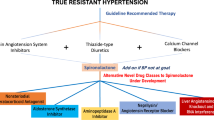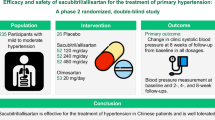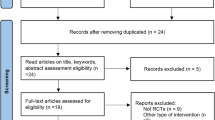Abstract
Mecamylamine (Inversine®), the first orally available antihypertensive agent, is now rarely used. Although celebrated in the 1950s, mecamylamine fell out of favour because of its widespread ganglionic side effects at antihypertensive doses (30–90 mg/day). However, recent studies suggest that mecamylamine is very effective at relatively low doses (2.5–5 mg b.i.d.) for blocking the physiological effects of nicotine and improving abstinence rates in smoking cessation studies, particularly for women. When these lower doses of mecamylamine are given, patients do not experience the severity of side effects that made the drug unpopular for the treatment of hypertension. Tobacco smoking is a strong risk factor for cardiovascular morbidity, including accelerated atherosclerosis and increased risk of heart attacks. Though currently untested, the available evidence suggests that low-dose mecamylamine therapy might reduce blood pressure variability and atherogenetic lipid profile in smokers. With this in mind, mecamylamine should be an important research tool in the field of hypertension research, particularly in recalcitrant smokers with mild to moderate hypertension.
This is a preview of subscription content, access via your institution
Access options
Subscribe to this journal
Receive 12 digital issues and online access to articles
$119.00 per year
only $9.92 per issue
Buy this article
- Purchase on Springer Link
- Instant access to full article PDF
Prices may be subject to local taxes which are calculated during checkout
Similar content being viewed by others
References
Schuller HM, Jull BA, Sheppard BJ, Plummer HK . Interaction of tobacco-specific toxicants with the neuronal alpha(7) nicotinic acetylcholine receptor and its associated mitogenic signal transduction pathway: potential role in lung carcinogenesis and pediatric lung disorders Eur J Pharmacol 2000; 393: 265–277
Plummer HK 3rd, Sheppard BJ, Schuller HM . Interaction of tobacco-specific toxicants with nicotinic cholinergic regulation of fetal pulmonary neuroendocrine cells: implications for pediatric lung disease Exp Lung Res 2000; 26: 121–135
Villablanca AC . Nicotine stimulates DNA synthesis and proliferation in vascular endothelial cells in vitro J Appl Physiol 1998; 84: 2089–2098
Saareks V et al. Clinical pharmacology of eicosanoids, nicotine induced changes in man J Physiol Pharmacol 2000; 51: 631–642
Stone CA, Torchiana ML, Navarro A, Beyer KH . Ganglionic blocking properties of 3-methylaminoisocamphane hydrochloride (mecamylamine): a secondary amine J Pharmacol 1956; 117: 169–183
Baer JE, Paulson SF, Russo HF, Beyer KH . Renal elimination of 3-methylaminoisocamphane hydrochloride (mecamylamine) Am J Physiol 1956; 186: 180–186
Martin BR, Onaivi ES, Martin TJ . What is the nature of mecamylamine's antagonism of the central effects of nicotine? Biochem Pharmacol 1989; 38: 3391–3397
Young JM, Shytle RD, Sanberg PR, George TP . Mecamylamine: new therapeutic uses and toxicity/risk profile Clin Ther 2001; 23: 532–565
Papke RL, Sanberg PR, Shytle RD . Analysis of mecamylamine stereoisomers on human nicotinic receptor subtypes J Pharmacol Exp Ther 2001; 297: 646–656
Reid MS, Mickalian JD, Delucchi KL, Berger SP . A nicotine antagonist, mecamylamine, reduces cue-induced cocaine craving in cocaine-dependent subjects Neuropsychopharmacology 1999; 20: 297–307
Blomqvist O, Engel JA, Nissbrandt H, Soderpalm B . The mesolimbic dopamine-activating properties of ethanol are antagonized by mecamylamine Eur J Pharmacol 1993; 249: 207–213
Rose JE, Sampson A, Levin ED, Henningfield JE . Mecamylamine increases nicotine preference and attenuates nicotine discrimination Pharmacol Biochem Behav 1989; 32: 933–938
Rose JE et al. Mecamylamine combined with nicotine skin patch facilitates smoking cessation beyond nicotine patch treatment alone Clin Pharmacol Therapeut 1994; 56: 86–99
Rose JE, Behm FM, Westman EC . Nicotine-mecamylamine treatment for smoking cessation: the role of pre- cessation therapy Exp Clin Psychopharmacol 1998; 6: 331–343
Rose J, Behm F, Westman E . Brand-switching and gender effects in mecamylamine/nicotine smoking cessation treatment In: 5th Annual Meeting of the Society for Research on Nicotine and Tobacco; 1999 March, 1999 San Diego, US: Society for Research on Nicotine and Tobacco 1999
Newman MB et al. Corticosterone-attenutating and anxiolytic properties of mecamylamine in the rat Neuro-Psychopharmacol Biol Psych 2000; 25: 609–620
Yokota T et al. Nicotine-sensitive paresis Neurology 1992; 42: 382–388
Newman M et al. Nicotine induced seizures blocked by (±)-mecamylamine and its stereoisomers Life Sci 2001; 69: 2583–2591
Silver AA et al. Multi-center double blind placebo controlled study of mecamylamine monotherapy for Tourette's disorder J Am Acad Child Adolescent Psych 2001; 40: 1101–1110
Shytle RD, Silver AA, Sanberg PR . Comorbid bipolar disorder in tourette syndrome responds to nicotinic receptor antagonist, mecamylamine (Inversine® Biol Psych 2000; 48: 1028–1031
Shytle RD et al. Neuronal nicotinic receptor inhibition for treating mood disorders: preliminary controlled evidence with mecamylamine Depression Anxiety 2002; (in press)
Shytle R et al. Nicotinic acetylcholine receptors as targets for antidepressants Mol Psych 2002; (in press)
Braddom RL, Johnson EW . Mecamylamine in control of hyperreflexia Arch Phys Med Rehabil 1969; 50: 448–453 passim
Braddom RL, Rocco JF . Autonomic dysreflexia. A survey of current treatment Am J Phys Med Rehabil 1991; 70: 234–241
Rose JE et al. Mecamylamine combined with nicotine skin patch facilitates smoking cessation beyond nicotine patch treatment alone Clin Pharmacol Ther 1994; 56: 86–99
Tennant FS Jr ., Tarver AL, Rawson RA. Clinical evaluation of mecamylamine for withdrawal from nicotine dependence NIDA Res Monogr 1984; 49: 239–246
Tennant FS Jr, Tarver AL . Withdrawal from nicotine dependence using mecamylamine: comparison of three-week and six-week dosage schedules NIDA Res Monogr 1984; 55: 291–297
Rose JE, Sampson A, Levin ED, Henningfield JE . Mecamylamine increases nicotine preference and attenuates nicotine discrimination Pharmacol Biochem Behavr 1989; 32: 933–938
Perkins KA . Smoking cessation in women. Special considerations CNS Drugs 2001; 15: 391–411
Dale LC et al. Bupropion for smoking cessation: predictors of successful outcome Chest 2001; 119: 1357–1364
Slemmer JE, Martin BR, Damaj MI . Bupropion is a nicotinic antagonist J Pharmacol Exp Ther 2000; 295: 321–327
Villablanca AC, McDonald JM, Rutledge JC . Smoking and cardiovascular disease Clin Chest Med 2000; 21: 159–172
Omvik P . How smoking affects blood pressure Blood Press 1996; 5: 71–77
Fogari R, Zoppi A, Malamani GD, Corradi L . Effects of calcium channel blockers on cardiovascular responses to smoking in normotensive and hypertensive smokers Int J Clin Pharmacol Res 1992; 12: 81–88
Ottesen MM, Worck R, Ibsen H . Captopril does not blunt the sympathoadrenal response to cigarette smoking in normotensive humans Blood Press 1997; 6: 29–34
Trap-Jensen J, Carlsen JE, Svendsen TL, Christensen NJ . Cardiovascular and adrenergic effects of cigarette smoking during immediate non-selective and selective beta adrenoceptor blockade in humans Eur J Clin Invest 1979; 9: 181–183
Zevin S, Jacob P 3rd, Benowitz NL . Nicotine-mecamylamine interactions Clin Pharmacol Ther 2000; 68: 58–66
Craig WY, Palomaki GE, Haddow JE . Cigarette smoking and serum lipid and lipoprotein concentrations: an analysis of published data Br Med J 1989; 298: 784–788
Augustin J, Beedgen B, Sophr U, Winkel F . The influence of smoking on plasma lipoproteins Inner Med 1982; 9: 104–108
Largue G et al. Nicotine gum and the lipid profile Patholog Biol 1989; 37: 937–941
Burch EA Jr, Kadowitz PJ, Kother Copes SMC, Namara DB Jr . The effect of alcoholism and smoking on platelet eicosanoid production in vitro, prostaglandins, leukotrienes essential Fatty Acids 1991; 42: 39–44
Booyse FM, Osikowicz G, Qarfoot AJ . Effect of Chronic Oral Consumption of Nicotine on the Rabbit Aortic Endothelium Am J Pathol 1981; 102: 229–238
Cluette-Brown J et al. Oral nicotine induces an atherogenic lipoprotein profile Proc Soc Exp Biol Med 1986; 182: 409–413
Kavitharaj NK, Vijayammal PL . Nicotine Administration induced changes in the gonadal functions in male rats Pharmacology 1999; 58: 2–7
Smith TH, Rossi GV . The effect of reserpine and mecamylamine on experimental atheromatosis in the normotensive and hypertensive rat J Pharmacol Exp Ther 1962; 135: 367–373
Author information
Authors and Affiliations
Corresponding author
Rights and permissions
About this article
Cite this article
Shytle, R., Penny, E., Silver, A. et al. Mecamylamine (Inversine®): an old antihypertensive with new research directions. J Hum Hypertens 16, 453–457 (2002). https://doi.org/10.1038/sj.jhh.1001416
Published:
Issue Date:
DOI: https://doi.org/10.1038/sj.jhh.1001416
Keywords
This article is cited by
-
Systemic injection of nicotinic acetylcholine receptor antagonist mecamylamine affects licking, eyelid size, and locomotor and autonomic activities but not temporal prediction in male mice
Molecular Brain (2022)
-
Promoting activity of (α4)3(β2)2 nicotinic cholinergic receptors reduces ethanol consumption
Neuropsychopharmacology (2020)
-
Neurochemical Evidence of Preclinical and Clinical Reports on Target-Based Therapy in Alcohol Used Disorder
Neurochemical Research (2020)
-
Effects of the nicotinic agonist varenicline, nicotinic antagonist r-bPiDI, and DAT inhibitor (R)-modafinil on co-use of ethanol and nicotine in female P rats
Psychopharmacology (2018)
-
New Pharmacological Agents to Aid Smoking Cessation and Tobacco Harm Reduction: What Has Been Investigated, and What Is in the Pipeline?
CNS Drugs (2016)



